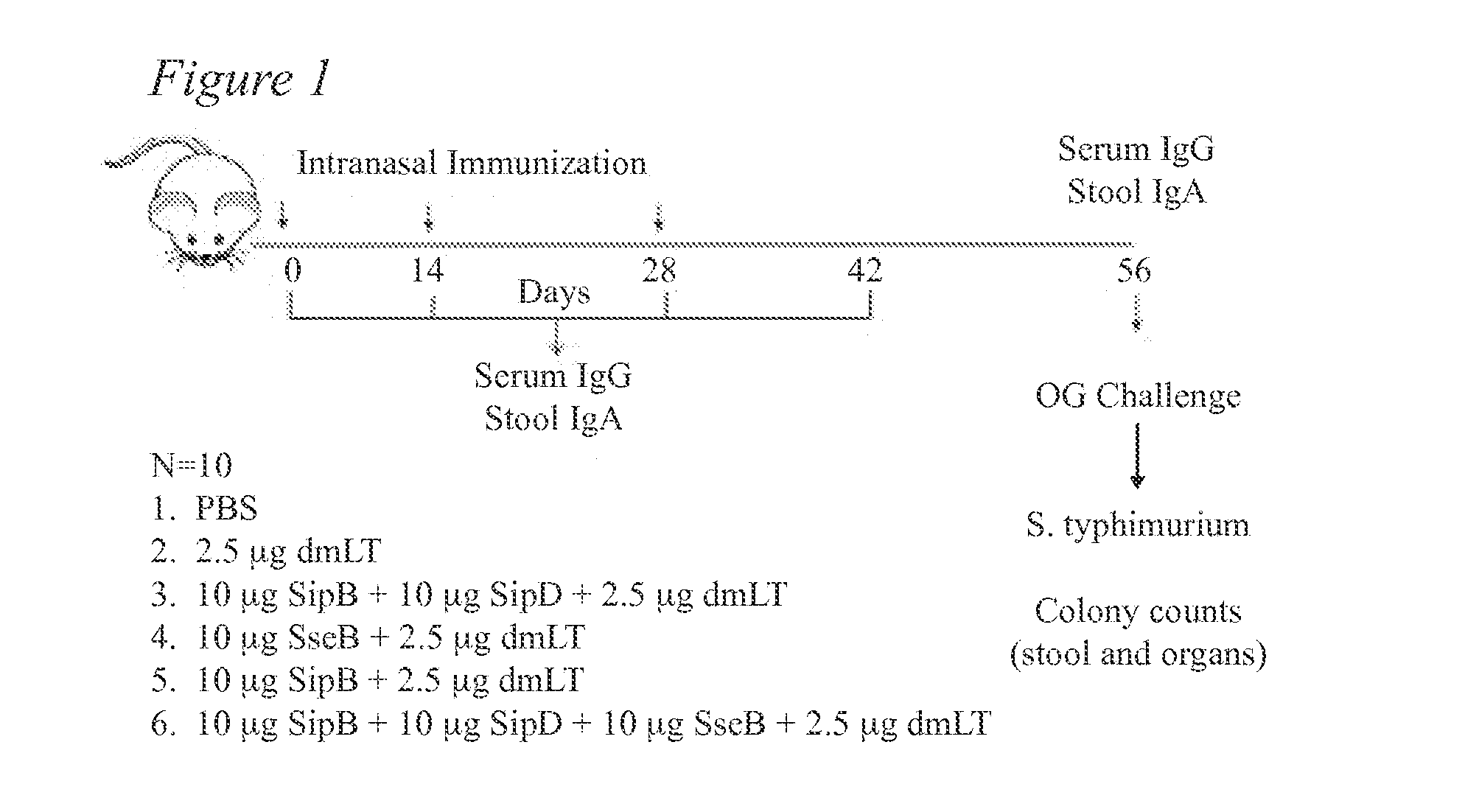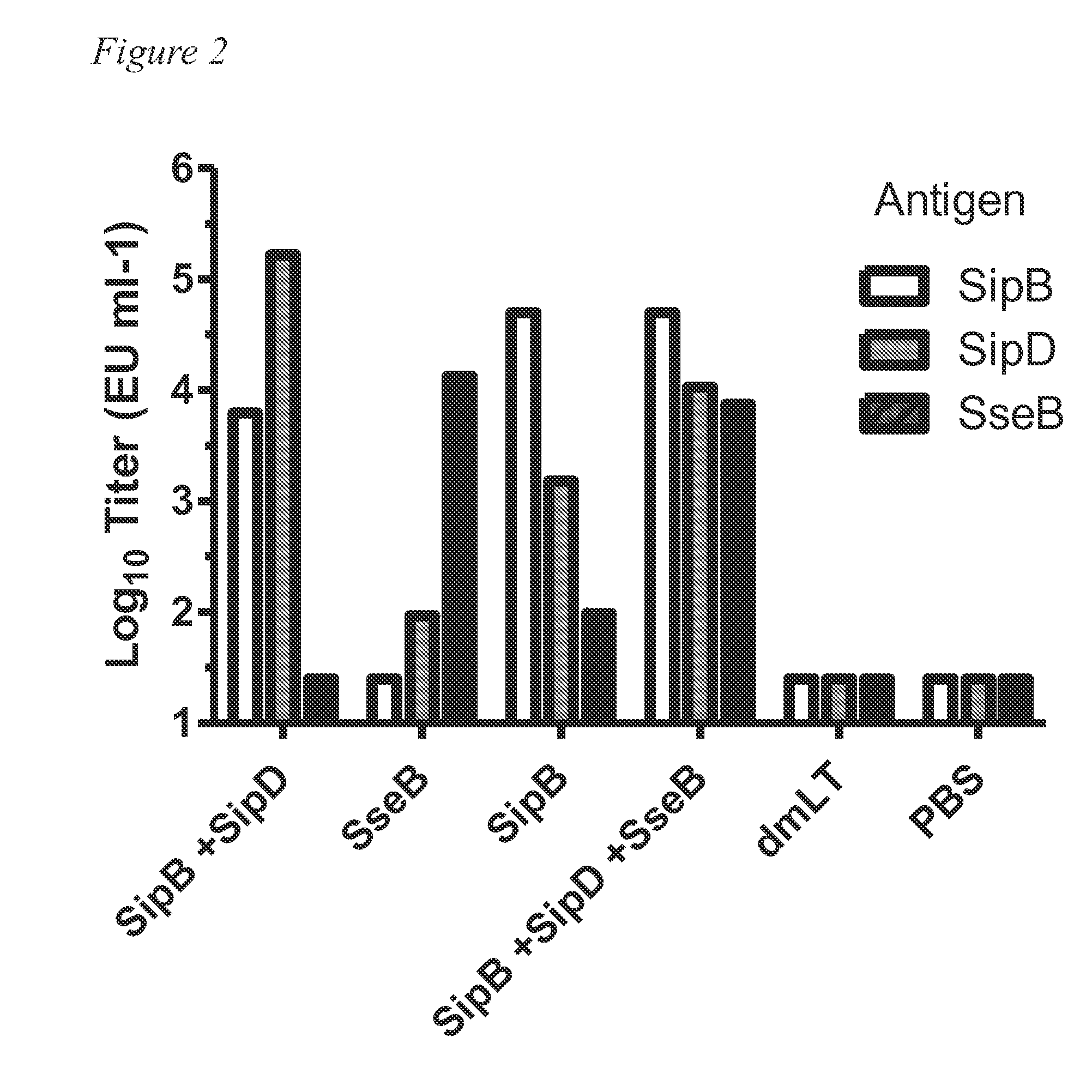Use of the salmonella spp type iii secretion proteins as a protective vaccination
- Summary
- Abstract
- Description
- Claims
- Application Information
AI Technical Summary
Benefits of technology
Problems solved by technology
Method used
Image
Examples
example 1
[0053]FIG. 1 provides a Schematic illustration of a first mouse testing protocol for Example 1. Briefly, Balb-c mice (N=5 per group) were immunized intranasally 2 times with Aro strain or 3 times (days 0, 14 and 28) with 10 μg each of SipB / SipD / SseB protein with or without dmLT. Serum IgG and stool IgA were monitored throughout. Serum IgG antibody titers at day 28 are shown in FIG. 2. Mice were orogastrically challenged with 108 colony forming units (CFUs) of Salmonella enterica serovar Typhimurium SL1344 after streptomycin treatment on day 56 and survival after challenge was monitored for 14 days after challenge. The results are shown in FIG. 3.
[0054]As can be seen, the proteins provide protection against a S. typhimurium challenge at a level approaching the live attenuated vaccine (Aro strain).
example 2
[0055]FIG. 4 provides a Schematic illustration of a mouse testing protocol for Example 2. Briefly, Balb-c mice, n=30) were immunized on Days 0, 14 and 28 as follows: Group A: 10 μg SseB+2.5 μg of dmLT (double mutant E. coli heat labile toxin) as adjuvant; Group B: 10 μg SipB+10 μg SipD+2.5 μg dmLT; Group C: 10 μg SseB+20 μg MPL (monophosphooryl Lipid A); Group D: 10 μg SipB+10 μg SipD+20 μg MPL; Group E: Aro (Aro attenuated S. enterica var. Typhimurium vaccine strain, “Typhimurium / Ty21 a strain”); Group F: phosphate buffered saline (PBS, i.e. vehicle). At day 42 post immunization, some mice were euthanized and their spleens were analyzed for antibody secreting cells (ASCs). On day 56, additional mice were euthanized and analyzed for ASCs, IFNγ secretion, and cytokine production, and the remaining mice were challenged with S. enterica typhi or typhimurium (typhoid models).
[0056]Immunogenicity as shown by spleen ASC results is shown in FIG. 5A-F. FIG. 6A-C shows IgG titers in immunize...
example 3
First Calf Testing
[0058]A schematic representation of the experimental protocol is provided in FIG. 9. Calves (21 day old male Holstein or Holstein-Jersey) were immunized subcutaneously at days 0, 14. 28 and 42 as follows: Group A, 2 mg SseB+50 μg of dmLT; Group B, Aro strain (Typhimurium); and Group C, PBS (control). Serum IgG (FIG. 10A) and saliva IgA (FIG. 10B) was measured. Calves were challenged with S. enterica Newport (9×105 CFUs) or Typhimurium (1.1×108 CFUs) on day 56. The amount of bacterial shedding in the two groups of challenged animals is shown in FIGS. 11A and B. As can be seen, the total bacterial shedding over the course of ten days for the group vaccinated with SseB+dmLT was not only lower, but the variation over the course of ten days was less than one log unit which is consistent with no effective increase in shedding over time. This is in contrast to the group vaccinated with PBS which had a higher average shedding and an average over the course of the study tha...
PUM
| Property | Measurement | Unit |
|---|---|---|
| Composition | aaaaa | aaaaa |
| Transport properties | aaaaa | aaaaa |
| Immunogenicity | aaaaa | aaaaa |
Abstract
Description
Claims
Application Information
 Login to View More
Login to View More - R&D
- Intellectual Property
- Life Sciences
- Materials
- Tech Scout
- Unparalleled Data Quality
- Higher Quality Content
- 60% Fewer Hallucinations
Browse by: Latest US Patents, China's latest patents, Technical Efficacy Thesaurus, Application Domain, Technology Topic, Popular Technical Reports.
© 2025 PatSnap. All rights reserved.Legal|Privacy policy|Modern Slavery Act Transparency Statement|Sitemap|About US| Contact US: help@patsnap.com



